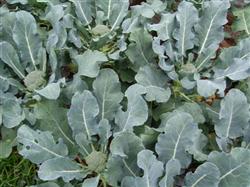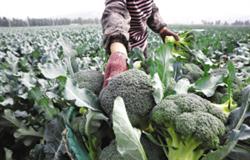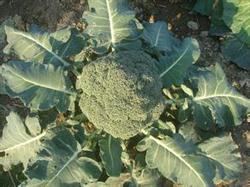Cultivation techniques of broccoli

Cauliflower, also known as cauliflower, Italian kale, green cauliflower, etc., is a variety of cabbage, herbaceous plants in 2012. Eat with green bouquets. It has good flavor and high nutritional value. Fresh green crisp and tender texture, refreshing and palatable flavor, has been recognized by the majority of urban and rural consumers, the consumption momentum is rising day by day, and the cultivation area is getting larger and larger. The main results are as follows: 1. the variety characteristic broccoli has developed root system and obvious main root; the leaves are lanceolate or long ovate, the leaf color is blue-green to dark blue-green, and the waxy layer is thicker, which is composed of more than 20 leaves; the economic yield part of the flower ball is composed of fleshy stem branches and dense flower buds; after the main flower ball is harvested, the axillary bud branches can continue to grow small florets, and its flavor and edible value remains unchanged. Therefore, it can also be harvested and listed many times in a row. The seeds are orchard-shaped and brown, with a general 1000-grain weight of 2.5ml / 4g. Second, the requirements for environmental conditions 1. Temperature: broccoli has strong cold resistance and heat resistance. The optimum temperature for seed germination is 25 ℃, the optimum temperature for growth and development is 20 ℃ 22 ℃, the optimum temperature for flower bud development is 15 ℃ 18 ℃, the growth is stunted above 25 ℃, the growth is slow below 5 Mel, and it can endure short-term frost. Although flower buds can also be produced in hot summer, they are thinner and of poor quality. 2. Light: broccoli is a low-temperature and long-day plant, which grows normally under sufficient light conditions. Insufficient light causes overgrowth of plants, elongation of flower stems and pedicels, loose and yellowing of flower bulbs. The conditions for the production and formation of broccoli bulbs are complicated, and the flower buds can begin to differentiate only after passing certain light and temperature conditions and completing the vernalization stage. 3. Soil and nutrients: broccoli is not strict on soil, but it is better to be cultivated in fertile loam field. It needs sufficient nutritional conditions in the process of growth and development, in addition to nitrogen, phosphorus, potassium, magnesium, sulfur and other elements, but also a certain amount of trace elements, fertilizer should pay attention to the combined application of various elements. In particular, nitrogen fertilizer should not be too much, otherwise it will easily lead to overgrowth of plants, excessive vegetative growth, delay the emergence of flower heads, and easily lead to rot and diseases. 4, moisture: broccoli, like a warm and humid environment, but can not be waterlogged, the appropriate soil relative humidity is 70% 80%, growing well in moist soil. According to the mature stage, broccoli can be divided into three types: early, middle and late ripening. At present, most of the varieties of broccoli cultivated in China are introduced from the United States, Japan and other countries. Different suitable varieties should be selected according to different cultivation seasons, the varieties with strong heat tolerance and early maturity should be selected for summer production, and the varieties with cold tolerance, compact plant type and solid flower head should be selected for winter production, mainly mid-maturing or mid-early-maturing varieties. 1. The hybrid generation of American broccoli introduced from the United States has strong plant growth, disease resistance and high yield. The height of the plant is about 55 cm, the flower ball is pine, dark green, and the weight of a single heading ball is 300 Mel 400 grams. The lateral branches are well developed and the yield of lateral bulbs is high. 2. Pearl green was introduced by Yulin Agricultural Science Research Institute. The plant height is about 40 cm. The bouquet weighs about 350 grams and is thick green in color. The plant has more wax powder and less black rot. About 60 days after planting, it can be harvested as an early-maturing variety with uniform bud differentiation period and concentrated harvest period. It has strong heat resistance and wide adaptability, so it is suitable for sowing and cultivation in spring, summer and autumn. The yield per mu is 1000 Mu 1500 kg. 3. The hybrid generation of Green Ridge introduced from Japan. The plant grows strongly. The plant height is about 40 cm. Bouquet oblate, light green. The flower bulb weighs 500Mel 700g, the ball is tight, there are many lateral branches, and the flowering ability is strong, and it is more productive. 4. The hybrid generation introduced from Japan can harvest mid-mature species about 80 days after planting. The flower ball weighs about 400 grams, convex and concave less, the flower ball is rich and beautiful. The bouquet is compact and the buds are fine and uniform. The main stem is thicker and not easy to be hollow. Because of the top bud type, it is not easy to get out of the side bud, and the work efficiency is high during harvest. It can be cultivated in autumn and winter. 4. Cultivation techniques 1. Cultivation season: sowing seeds at any time in South China from July to January of the following year. The early and middle mature seeds were mainly used. The low temperature condition required by late-maturing varieties can not be met, so it is not suitable to be used. 2. Sowing and raising seedlings: (1) preparation before sowing: broccoli can be sown and raised seedlings with nutrition cup or seedling bed. First prepare nutritious soil with nutrition cup to raise seedlings; select 3 parts of garden soil or paddy soil that have not planted cruciferous vegetables within 3 years, add 1 part of fully mature farm manure, and then add 1 kg of calcium superphosphate per cubic meter of nutrient soil. Potassium sulfate 0.6 kg or biological potassium 0.5 kg, fully mixed, cup For those who raise seedlings with a nursery bed, choose the convenient loam for drainage and irrigation to form a furrow with a width of 1.7m / m and a height of 20m / 25cm, which is used as a nursery bed. After applying 15kg mature organic fertilizer per square meter, and applying a certain amount of phosphate and potassium fertilizer, mix the fertilizer with the soil and rake it to level the sowing. (2) sowing: sowing in a nutrition cup, sowing the nutrient soil before sowing, sowing 1 grain in each cup, covering with thin soil after sowing, spraying herbicides; sowing in the seedbed, mixing the seeds with a certain amount of fine sand before sowing, the sowing rate is 4rel 5 grams per square meter (that is, 5 square meters of seedlings can be planted in one mu). After sowing, cover with 0.5cm2 thin soil, wet and spray Duer herbicide, then cover with a thin layer of straw. Sowing in late summer and early autumn, the weather is still in the high temperature and rainy season, no matter the nutrition cup or seedbed seedling, it is necessary to pull the sunshade net to protect against rain. (3) Seedling stage management after sowing: pay attention to watering after sowing, often keep the soil moist, nursery bed seedlings can be completed in about 3 days, and rice seedlings should be removed in time. During the emergence period, the relative humidity of the soil was maintained at 70 / 80%. Replenish water as appropriate after finishing the seedling. When raising seedlings in summer, special attention should be paid to the prevention and control of yellow striped beetles and cabbage insects at seedling stage. The shading net should be removed 10 days before transplanting, so that the seedlings can fully see the light and refine the seedlings. Broccoli seedling standard: the plant height is about 15 cm, the stem diameter is 0.6 ~ 0.8 cm, and the number of leaves is 4 ~ 5. 3, planting and field fertilizer and water management (1) planting: before planting, sufficient base fertilizer must be applied properly, broccoli plants are tall, the growth is large, the requirements for soil nutrition conditions are high, convenient drainage and irrigation should be selected, and sufficient base fertilizer should be applied. 2000Lue 2500kg of rotten farm manure per mu, boron fertilizer and calcium fertilizer should be properly applied, and the base fertilizer should be evenly mixed in the soil. The planting choice is sunny afternoon, double-row planting, the distance between plants is 30m ~ 40cm, 3000 plants are planted per mu of early-maturing species and 2000m ~ 2500 plants of middle-maturing species. (2) Field fertilizer and water management: broccoli likes fertilizer and water, and topdressing and watering by stages is the key to high yield. Nitrogen fertilizer is the main type of topdressing. In the early stage of growth, topdressing 2MUR is applied three times, and each time 2530 piculs of rotten manure and urine, or 8MUR of urea is applied each time. Enter the flower ball formation stage, apply heavy fertilizer, compound fertilizer (preferably organic compound fertilizer) 25ml / mu, add appropriate amount of magnesium, calcium, sulfur, boron fertilizer, etc., and combine with mid-tillage to cultivate soil. When entering the harvest period, topdressing should be applied once after each harvest to promote the growth of lateral flower heads and apply compound fertilizer 15kg / mu to 20kg / mu. Broccoli needs more water, especially in the period of flower head formation, it is necessary to irrigate in time to keep the soil moist. It should be drained in time in the rainy season so as not to cause retting. 4. Pest control: the common diseases and insect pests of broccoli are black spot, downy mildew, aphids, cabbage green insects, Plutella xylostella, yellow striped beetle, cabbage night moth and so on. (1) Disease control: black spot can be sprayed with 50% carbendazim 500 times, or 65% Dysen zinc 500 times, or 50% methyl thiophanate 500 times, for 3 consecutive times, once every 7 days; downy mildew: 58% carbendazim 600 times, or 64% alum 500 600 times at the initial stage of the disease. Or 75% of the bacteria clear 600 times liquid spray, continuous spray 2 Mel 3 times, spray once every 7 days, and pay attention to the alternate use of drugs. (2) pest control: aphids can be sprayed with 1000 dimethoate; cabbage moth, cabbage moth, yellow striped beetle and cabbage armyworm can be sprayed with 1000 times of 80% dichlorvos emulsion or 2.5% deltamethrin 2500 times, or 20% cypermethrin 2000 times. 5. Harvest: the top bulb of broccoli plant has been fully enlarged. When the bud is not yet open, it should be harvested in time to avoid loose balls or flowering caused by late harvest. When harvesting, cut off the lower part of the flower bulb with a flower stem of about 10 cm. After the top bulb was harvested, the axillary buds of the plant germinated, and the lateral branches grew rapidly, and then formed a bouquet at the top of the lateral branches, that is, the lateral bouquet. When the lateral bulb grows to a certain size and the bud has not yet opened, it can be harvested again, so that 2 Mel can be harvested 3 times in succession.
- Prev

Occurrence and control of hollow in main stem of broccoli
Broccoli, also known as broccoli, is suitable for growing in cool climates. its products have tender texture, unique flavor and rich nutrition, especially high vitamin C content, so it is a fashionable high-grade vegetable. Lantian County mountain area due to high altitude, cool and humid summer climate, few diseases and insect pests, suitable for broccoli growth, especially.
- Next

Production and control methods of heterochromatic flower bulbs in broccoli
Broccoli, also known as green cauliflower, broccoli, like cool climate, the summer sowing cultivation techniques are introduced as follows: 1. Pre-preparation (1) varieties. The first generation hybrid varieties with early maturity, strong stress resistance and the highest yield were selected. The main varieties are jade crown, super jade crown, ten thousand green and so on. (2) parcels. Rich in organic matter is required.
Related
- Where is it suitable to grow horseradish in China? it is expected to see the middle altitude horseradish in Alishan.
- How to prevent tomato virus disease reasonably? (Control methods included)
- Many people like to plant towel gourd on the balcony. What are the main points of this method and management?
- What crops can chili peppers be mixed with?
- Fertilization techniques and matters needing attention in Tomato
- What are the grafting techniques for peach seedlings in spring?
- Harm and control methods of root swelling disease of Chinese cabbage
- What are the pests of sweet potatoes? How to prevent and cure it?
- Symptoms, causes and Control methods of navel Rot in Tomato
- The cause of "Cucumber rotten bibcock" in Farmers' planting Cucumber and its Control Plan

